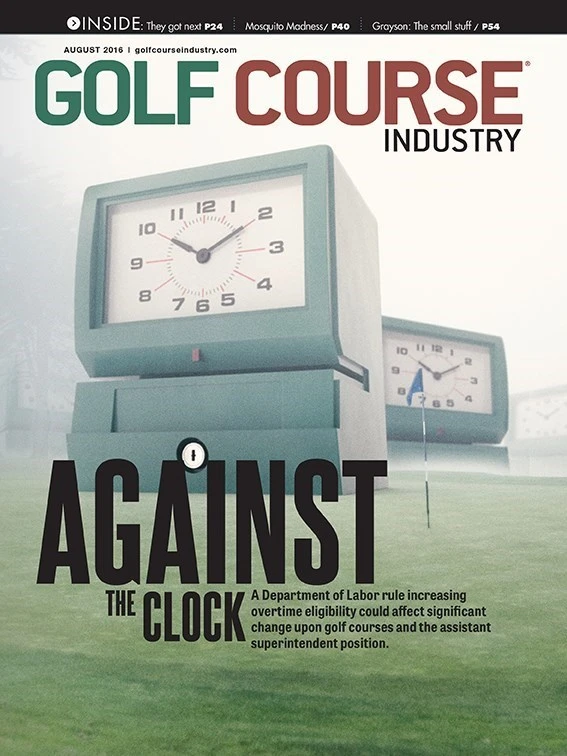Every few years I’m compelled to write a column for the members, golfers and guests who enjoy the turf you’re responsible for. No matter how many public-service ads or articles about the super at the major-championship venues, I’m struck by everyday golfers lack of knowledge, understanding and compassion.
So, it’s time again. Get your pro, GM or locker-room guy to post this somewhere prominent. I’m can’t promise it will do much good, but we’ve got to keep trying.
Dear Member:
I’m writing this because despite your love for golf, you don’t know one important fact: Maintaining a golf course is hard. It’s something your super and his crew know too well, but are afraid to say it without thinking they’re complaining.
No, I’m not asking for sympathy: Your superintendent and crew chose this profession knowing how difficult it can be. But because they work from very early until dark, they don’t have free time to educate you about what they’re doing and why. So all I’m asking is take a few minutes to read what follows, think about it, maybe seek out your super and ask questions, and come away with a better understanding of what it takes to keep grass green, rough tamed, greens firm and true, bunkers pure, trees and shrubs pruned, leaves raked, and 150 acres or more in prime condition.
Let me start recalling what I recently read on a T-shirt being sold to course personnel: “I solve problems you don’t know you have in ways you don’t understand.” That about says it all.
Unless you’ve done the job, don’t complain about your course’s conditioning until you know the facts; plus chemistry, labor management practices, environmental regulations, meteorology and a dozen other disciplines.
And just because you mow your lawn, doesn’t mean you know what we do. You’re not putting on that lawn, are you?
Your course superintendent faces countless obstacles, challenges and pitfalls to get his, or her, job done. The two biggest challenges? Weather and people.
Particularly in summer, conditioning issues are exacerbated by heat, rain, humidity and their collective unreliability. But there are problems throughout the year, including wind, rain, snow, sunlight—both not enough and too much of each. If you dismiss the weatherperson on your local news with, “What does he know?” imagine how your maintenance crew feels. We prepare as best we can for what is going to happen. But we can only react to the weather, not out-think it.
As for personnel, labor issues are often more serious than the weather. Workers aren’t knocking down our doors asking to be paid minimum wage and brave the elements from sun-up to sundown. Most superintendents can’t find good assistants let alone reliable hourly workers. But somehow, they do, and hope the best of them show up again the next day, next week, next month, next year.
Don’t think, “Wow, what a great job. You get to work outside, get exercise and ride around on tractors.” It’s harder to find young people, or any people, who want the long hours and low pay. The industry is facing a crisis with the millennial generation, who don’t think hot, cold, wet and everything in-between makes for an ideal work environment.
Every region has its own problems. For example, in the Northeast, when late March offers up that rare warm day, club members want to know why the course isn’t tournament ready and green. That early in the year maintenance crews are skeletal, grass is just starting to grow, and it was 40 degrees the day before with frost on the ground.
We can’t simply throw a switch and create July-like conditions.
If you like to play early in the morning, good for you. But realize even though the crew has been out for about an hour, they’re still getting the course ready for a full day of play. What has to be done first thing? Set tee markers, move cart signs, fill ball washers, check water coolers, change hole locations, blow leaves and other detritus off cart paths, clean restrooms, roll greens, fill divots, trim and/or mow selected areas, rake bunkers, water greens … That’s why early guys might catch up to the crew and play a few of imperfect holes.
Here’s a thought: Why not stop and say thank you? Remember how I said it’s a hard job? It still is. But we love it, and we want you playing on a course that’s in the best possible shape. We want you to have fun and come back again. But for you to have fun, we have to work hard.
One last point: Our job would be easier if you’d replace divots, fix ball marks, not drive the cart onto the tees and greens, not drag your cleats across the green, put cigar and cigarette butts in ashtrays, pick up broken tees, and not slam your driver/3-wood/wedge/putter into the ground when you hit a bad shot.
Do that and we’ll gladly say “thank you” to you. Play well.
Get curated news on YOUR industry.
Enter your email to receive our newsletters.
Explore the August 2016 Issue
Check out more from this issue and find your next story to read.
Latest from Golf Course Industry
- The Cabot Collection announces move into course management
- Carolinas GCSA raises nearly $300,000 for research
- Advanced Turf Solutions’ Scott Lund expands role
- South Carolina’s Tidewater Golf Club completes renovation project
- SePRO to host webinar on plant growth regulators
- Turfco introduces riding applicator
- From the publisher’s pen: The golf guilt trip
- Bob Farren lands Carolinas GCSA highest honor






